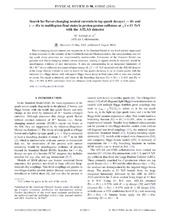Search for flavor-changing neutral currents in top quark decays t→Hc and t→Hu in multilepton final states in proton-proton collisions at √s=13 TeV with the ATLAS detector
Aaboud, Morad; Aad, Georges; Abbott, Brad; Abdinov, Ovsat Bahram oglu; Abeloos, Baptiste; Abhayasinghe, Deshan Kavishka; Abidi, Syed Haider; AbouZeid, Hass; Abraham, Nadine L.; Abramowicz, Halina; Buanes, Trygve; Eigen, Gerald; Fomin, Nikolai; Lipniacka, Anna; Martin dit Latour, Bertrand; Mæland, Steffen; Stugu, Bjarne; Yang, Zongchang; Zalieckas, Justas; Bugge, Magnar Kopangen; Cameron, David Gordon; Catmore, James Richard; Feigl, Simon; Franconi, Laura; Garonne, Vincent; Gramstad, Eirik; Hellesund, Simen; Morisbak, Vanja; Oppen, Henrik; Ould-Saada, Farid; Pedersen, Maiken; Read, Alexander Lincoln; Røhne, Ole Myren; Sandaker, Heidi; Serfon, Cédric; Stapnes, Steinar; Vadla, Knut Oddvar Høie; Abreu, Henso; Abulaiti, Yiming; Acharya, Bobby S.; Adachi, Shunsuke; Adamczyk, Leszek; Adelman, Jareed; Adersberger, Michael; Adigüzel, Aytül; Adye, Tim; Affolder, Anthony Allen; Afik, Yoav; Agheorghiesei, Catalin; Aguilar Saavedra, Juan Antonio; Ahmadov, Faig; ATLAS, Collaboration
Peer reviewed, Journal article
Published version

Åpne
Permanent lenke
https://hdl.handle.net/1956/20567Utgivelsesdato
2018-08-06Metadata
Vis full innførselSamlinger
Originalversjon
https://doi.org/10.1103/physrevd.98.032002Sammendrag
Flavor-changing neutral currents are not present in the Standard Model at tree level and are suppressed in loop processes by the unitarity of the Cabibbo-Kobayashi-Maskawa matrix; the corresponding rates for top quark decay processes are experimentally unobservable. Extensions of the Standard Model can generate new flavor-changing neutral current processes, leading to signals which, if observed, would be unambiguous evidence of new interactions. A data set corresponding to an integrated luminosity of 36.1 fb−1 of pp collisions at a center-of-mass energy of ffiffi s p ¼ 13 TeV recorded with the ATLAS detector at the Large Hadron Collider is used to search for top quarks decaying to up or charm quarks with the emission of a Higgs boson, with subsequent Higgs boson decay to final states with at least one electron or muon. No signal is observed and limits on the branching fractions Bðt → HcÞ < 0.16% and Bðt → HuÞ < 0.19% at 95% confidence level are obtained (with expected limits of 0.15% in both cases)
